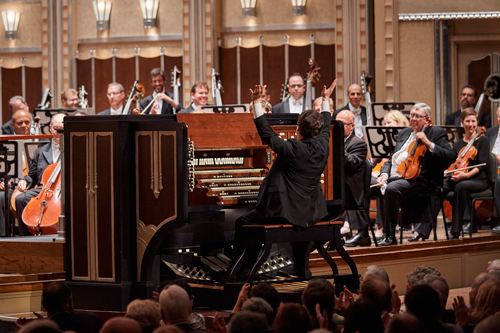by Daniel Hathaway

Viennese composer Bernd Richard Deutsch was on hand for the U.S. premieres of his Okeanos for organ and orchestra, the centerpiece of this series of concerts. I heard the performance on Sunday, March 17, when the piece had already enjoyed three previous hearings and sounded confident and settled.
Its Greek title refers to the mythological Titan who rules over the oceans, and its four movements invoke the primal elements of earth, air, fire, and water. That’s “an idea of immense (and sometimes unfathomable) greatness and breadth,” Deutsch wrote in his program notes, and it conjured up in his mind the thought of the organ.
The combination of a large, orchestral-style organ and a huge symphony orchestra gave Deutsch a broad tonal palette to work with, and he delights in its vast color and dynamic possibilities in Okeanos. The organ sometimes comes to the fore as a soloist, but just as often it melds its own imaginative sounds with fascinating instrumental combinations to produce new hues and textures, enhanced by a whole battery of judiciously scored percussion instruments, pitched and not.
Jacobs was in complete control of his daunting organ part, which required him to play virtuosic, repetitive figures and multiple pedal notes, and make frequent stop changes. Now and again, Deutsch lets the organ loose in idiomatic toccata-like sections, but he uses the instrument in novel ways as well. Franz Welser-Möst was efficient in his stage manager-like role, cuing entrances and adjusting balances.
The audience seemed raptly engaged by the new work, awarding Jacobs and the composer an enthusiastic ovation. Here’s hoping that enterprising orchestras will give the organist other opportunities to play a piece that he so obviously believes in and has mastered.
You’d think that after a hundred years in business, one of the world’s great orchestras would have already made its way through all of Haydn’s 104 symphonies. Not so with No. 34, written around 1765, which had its first Cleveland Orchestra outing at these concerts. Notable for its Adagio first movement, which stays in d minor before shifting into Major for the rest of the work, the piece made a lovely opening gesture on the program and a complete contrast with Tchaikovsky’s Fifth Symphony at the other end.
Welser-Möst and the Orchestra brought transparency, grace, and charm to the Haydn and robust, sonic magnificence to the Tchaikovsky, a work that figures importantly in the Orchestra’s forthcoming Asia Tour programs. It should make a big impression, with its brooding introduction, gorgeous horn solo in the slow movement, glorious waltz, and triumphant finale — especially if the latter is allowed to become spacious and grand. On Sunday, it very well might have set a speed record.
Published on ClevelandClassical.com March 25, 2019.
Click here for a printable copy of this article



